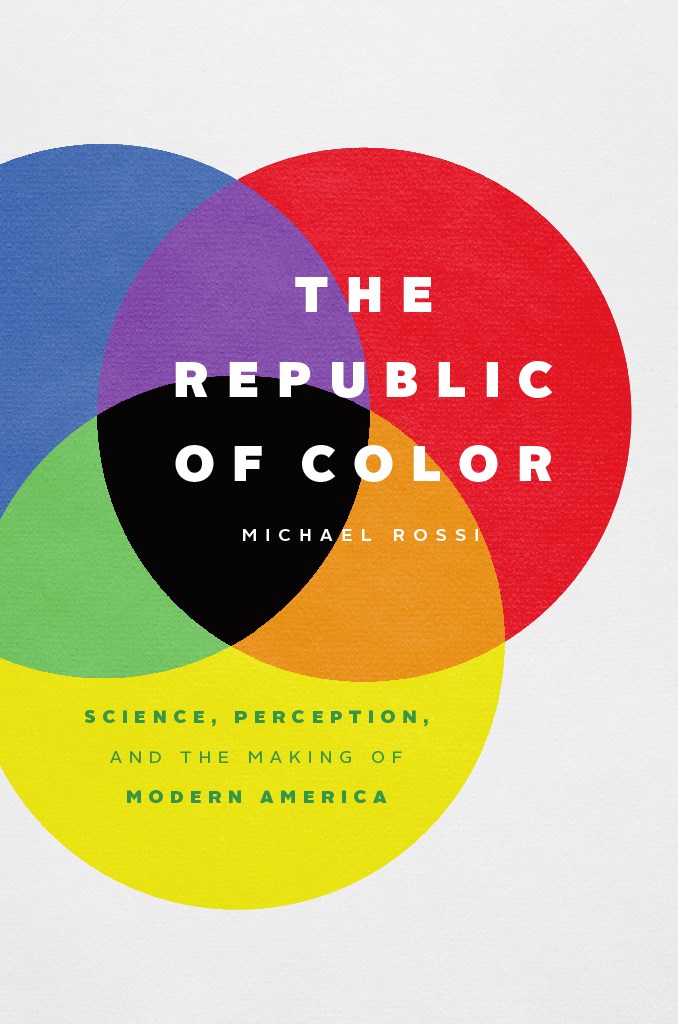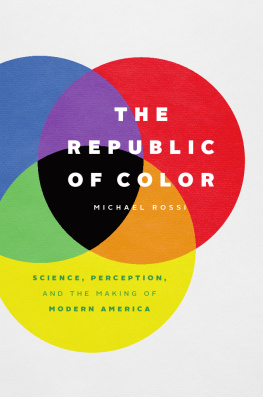Michael Rossi - The Republic of color; Science, Perception, and the Making of Modern America
Here you can read online Michael Rossi - The Republic of color; Science, Perception, and the Making of Modern America full text of the book (entire story) in english for free. Download pdf and epub, get meaning, cover and reviews about this ebook. year: 2019, publisher: University of Chicago Press, genre: Science. Description of the work, (preface) as well as reviews are available. Best literature library LitArk.com created for fans of good reading and offers a wide selection of genres:
Romance novel
Science fiction
Adventure
Detective
Science
History
Home and family
Prose
Art
Politics
Computer
Non-fiction
Religion
Business
Children
Humor
Choose a favorite category and find really read worthwhile books. Enjoy immersion in the world of imagination, feel the emotions of the characters or learn something new for yourself, make an fascinating discovery.
- Book:The Republic of color; Science, Perception, and the Making of Modern America
- Author:
- Publisher:University of Chicago Press
- Genre:
- Year:2019
- Rating:4 / 5
- Favourites:Add to favourites
- Your mark:
- 80
- 1
- 2
- 3
- 4
- 5
The Republic of color; Science, Perception, and the Making of Modern America: summary, description and annotation
We offer to read an annotation, description, summary or preface (depends on what the author of the book "The Republic of color; Science, Perception, and the Making of Modern America" wrote himself). If you haven't found the necessary information about the book — write in the comments, we will try to find it.
Michael Rossi: author's other books
Who wrote The Republic of color; Science, Perception, and the Making of Modern America? Find out the surname, the name of the author of the book and a list of all author's works by series.
The Republic of color; Science, Perception, and the Making of Modern America — read online for free the complete book (whole text) full work
Below is the text of the book, divided by pages. System saving the place of the last page read, allows you to conveniently read the book "The Republic of color; Science, Perception, and the Making of Modern America" online for free, without having to search again every time where you left off. Put a bookmark, and you can go to the page where you finished reading at any time.
Font size:
Interval:
Bookmark:

MICHAEL ROSSI
THE UNIVERSITY OF CHICAGO PRESS
CHICAGO AND LONDON
The University of Chicago Press, Chicago 60637
The University of Chicago Press, Ltd., London
2019 by The University of Chicago
All rights reserved. No part of this book may be used or reproduced in any manner whatsoever without written permission, except in the case of brief quotations in critical articles and reviews. For more information, contact the University of Chicago Press, 1427 E. 60th St., Chicago, IL 60637.
Published 2019
Printed in the United States of America
28 27 26 25 24 23 22 21 20 19 1 2 3 4 5
ISBN-13: 978-0-226-65172-9 (cloth)
ISBN-13: 978-0-226-65186-6 (e-book)
DOI: https://doi.org/10.7208/chicago/9780226651866.001.0001
Publication of this book has been aided by a grant from the Bevington Fund.
Library of Congress Cataloging-in-Publication Data
Names: Rossi, Michael (Historian of science), author.
Title: The republic of color : science, perception, and the making of modern America / Michael Rossi.
Description: Chicago ; London : The University of Chicago Press, 2019. | Includes bibliographical references and index.
Identifiers: LCCN 2019008626 | ISBN 9780226651729 (cloth : alk. paper) | ISBN 9780226651866 (e-book)
Subjects: LCSH: Color visionResearchUnited StatesHistory19th century. | Color visionResearchUnited StatesHistory20th century. | ColorResearchUnited StatesHistory. | ScienceSocial aspectsUnited States. | United StatesCivilization18651918.
Classification: LCC QP483.R67 2019 | DDC 612.7/927dc23
LC record available at https://lccn.loc.gov/2019008626
 This paper meets the requirements of ANSI / NISO Z39.481992 (Permanence of Paper).
This paper meets the requirements of ANSI / NISO Z39.481992 (Permanence of Paper).
And suddenly there came a sound from heaven as of a rushing mighty wind, and it filled all the house where they were sitting. And there appeared unto them cloven tongues like as of fire, and it sat upon each of them. And they were all filled with the Holy Ghost, and began to speak with other tongues, as the Spirit gave them utterance.
ACTS 2:24
Consumed by darkness, the dying sun flickered angrily in the sky. From a makeshift observatory in Princeton, New Jersey, Joseph Henry and Stephen Alexanderprofessors of natural philosophy at the nearby College of New Jersey
Seventeen years later, on the occasion of another eclipsethe big eclipse of 1855Henry, now secretary of the Smithsonian Institution in Washington, DC, recalled his luminous vision of 1838 before an audience, sketching, as one reporter put it, a circle of cloven tongues of fire on a blackboard and describing in rapturous detail the beautiful pink color of the flames. But this time, Henry was no longer certain that hed actually glimpsed a new, physical fact on that fall day in 1838. Rather than a vision of the sun, Henry had come to suspect that hed been fooled by his own perceptions. As he told the assembled crowd, he now believed that the colorful projections that he had seen emanating from the sun were what he called subjective phenomenaaccidents of vision; colors in the eyerather than immediate qualities of the physical world. Should this be the case, Henry mused, the pink protuberances on the sun would open a field of investigation, a new scientific discipline focused on the character and functioning of human sensations. This was, on the one hand, an exciting prospect to researchers such as Henry. A science predicated upon, in essence, observing observation would extend the reach of scientific inquiry into hitherto-unknown, intimate, and off-limits areas of human existence. On the other hand, it had unsettling implications. For if Henry, a man trained to observe and record reality with unsparing accuracy, could nevertheless so easily fail to distinguish that which was real from that which was a product of his own mind, the possibility arose that all observationsindeed, all the empirical facts upon which civilized humankind built collective knowledgewere based not on facts of the objective world but rather on subjectively variable individual perceptions.
This is a book about how this field of investigation developed into color science: a polyglot endeavor comprising the physics, physiology, psychology, anthropology, philosophy, and aesthetics of human color vision. From pink protuberances in an astronomers eye to precipitates of Prussian blue; from the color of railroad signals in New England to the color of the Arctic Ocean; from the brilliance of lemons to the deep black of coal; from mysterious isabel to enigmatic elephants breath; from the colors of canaries to the colors of skincolor mattered deeply to nineteenth-century Americans. Between the time of Henrys vision of cloven tongues of fire and the middle of the twentieth century, an expansive array of scientists, government administrators, artists, educators, laborers, and industrialistsamong many other groups and many other communitiesworked to define and redefine, explain and reexplain, what it meant to experience color. They devised tests and regulations for indicating color sensations; they argued over relationships between labor and aesthesis; they constructed pedagogical programs for teaching color vision to schoolchildren and territorial subjects; they crafted new philosophies of logic and mind based on principles of scientific color perception; they made models of standard color relationships and color harmonies and attempted to coordinate them with ideas of ideal observers. And in doing all these things (and more) they formulated not simply laws of perception but a republic of color: an ideological, administrative, and political apparatus for ensuring that all those who could experience color would do so with the moral and aesthetic cohesion required of a rapidly expanding and self-consciously modernizing American nation.
In twenty-first-century writing on culture and history, color holds a peculiar ground. It is at once an aspect of the world that is generally assumed to be meaningful to all human beings, and yet it stands out as especially important to the historical production of industrial modernity. In the first instance, a large and ever-growing body of scholarly and popular literature explores the historical significance of colorsexamining both the relationship between color and visual culture in general and the symbolism attached to particular colors in particular times and places.
Hidden beneath these questions of the general meanings and specific manufactures of colors, however, lies a deeper question about how individuals came to know and understand sensory qualities, how this knowledge shaped scientific understandings of bodies and political subjectivity, and how, therefore, beliefs about color came to possess the manifold explanations for cultural production that they do today.and pluralistic country to think about color as meaningful at alllet alone meaningful according to the standards of science. It is a story of arguments and ideas, experiments and misunderstandings, moralisms and formalisms. And it is a story, ultimately, about how colorthat seemingly simple, yet infinitely protean object of desirecontinually slipped from the grasp of its pursuers.
Americans did not invent inquiries into the nature of color, nor was color a problem unique to the nineteenth century. In the ancient world, Plato, Aristotle, and Democritus, among others, speculated in detailed and often-perplexing passages about the nature and mixture of colors. Sometimes explicitly, often implicitly, American color scientists worked against the backdrop of this centuries-old scholarship about color theory and color character. Color theory in the United States was notintellectually or materiallya land out of time.
Next pageFont size:
Interval:
Bookmark:
Similar books «The Republic of color; Science, Perception, and the Making of Modern America»
Look at similar books to The Republic of color; Science, Perception, and the Making of Modern America. We have selected literature similar in name and meaning in the hope of providing readers with more options to find new, interesting, not yet read works.
Discussion, reviews of the book The Republic of color; Science, Perception, and the Making of Modern America and just readers' own opinions. Leave your comments, write what you think about the work, its meaning or the main characters. Specify what exactly you liked and what you didn't like, and why you think so.











